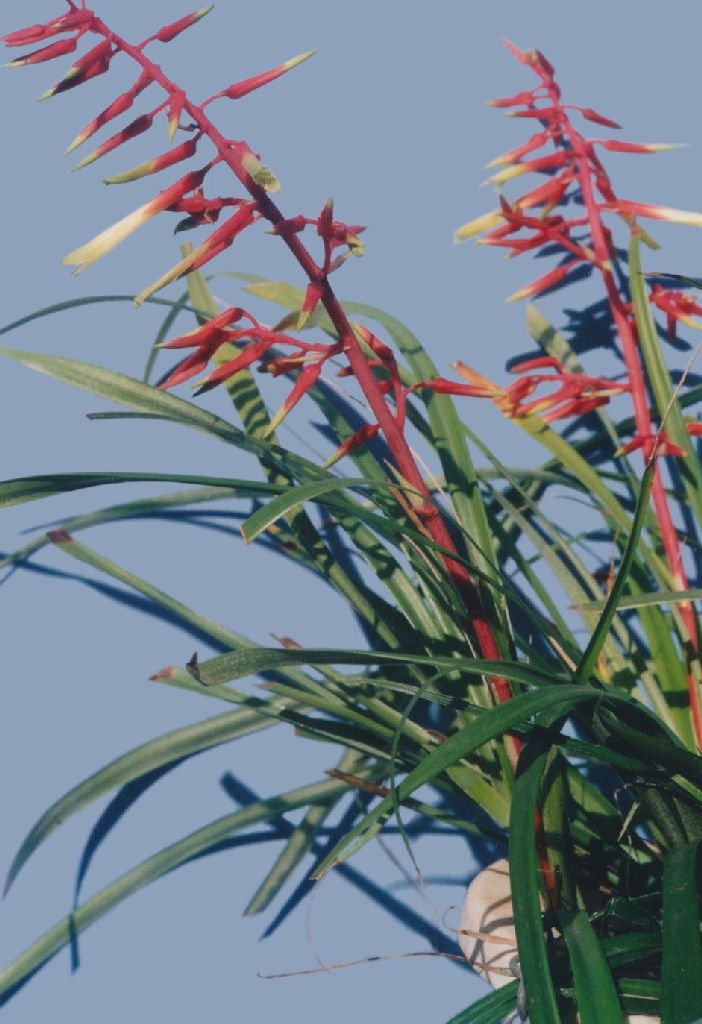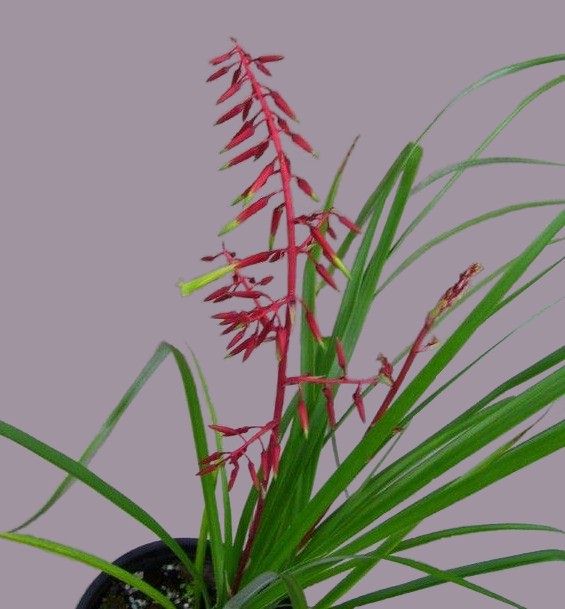

Pitcairnia inermis by Derek Butcher July 2013
To those of you who query what is on the label and look into anomalies you often get that warm fuzzy feeling when you find a true anomaly. One such person is Ross Little who flowered a plant from Peter Tristram called Pitcairnia inermis var flava but the problem was that it had green petals and the petals had appendages. So he contacted me. In South Australia, Keith Bradtberg had already flowered a similar plant from Peter in the 1990’s only at that time we had different worries as the following article written by me in 2004 shows..
Pitcairnia inermis var. flava by Butcher 2004
This plant was imported from the USA as Pitcairnia vargasiana by Peter Tristram in the 1980’s and an offset found its way to South Australia in 1989. I came into the picture in the mid 1990’s and suggested the plant was wrongly named. I even took it to pieces in my search! In 1996 I took a photograph with me to the Orlando Conference and spoke to Harry Luther about my problem. Harry agreed it was not P. Vargasiana but because I spoke to him at the Conference and not when he was home at Selby Gardens he was unable to advise further.
In June 1999 I again saw this plant in flower and was allowed to take it home for “homework”.
Using the key in Smith and Downs I kept stumbling across Pitcairnia inermis but the sepals were pointed to my mind but the description said obtuse! That was until I saw the line drawing of the sepal and it was the same shape as mine! Secondly I was worried about the petals which were yellow not red and there was no appendage at the base. What was a surprise was the fact that these two criteria were how Lyman Smith differentiated between the type species and the variety flava. It was a surprise because on the one hand we had Lyman Smith splitting two genera, namely Tillandsia and Vriesea on petal appendages and here he was not splitting at species level! You are never too old to learn.
Everything clicked from then on so I’m quite sure that the plant should have been identified as P. Inermis var. flava. It comes from 2000 m altitude in Central Peru and shares a similar habitat to the less-well documented P. Vargasiana.
In June 2013 we again contacted Peter Tristram and got more information. The plant originally came from Rob Phillips, collected in Peru about 1985 and flowered in quarantine (Peter at that time had his own Quarantine house). Most of the fantastic stuff he collected took exception to the Methyl Bromide treatment and abruptly died. He grew on some seed. Harry named it P. Vargasiana. Peter was still doubtful as to what it really was and it may be an undescribed species. He assumed at the time that Rob had collected it near Tarapoto or Moyabamba but he also went to Tingo Maria and the Machu Picchu area, with Lee Moore, the Adventurer.
Back to the books because these days there is a wealth of information available to use, courtesy of the internet. Big problems! We have conflicting information. In the original description of P. Inermis, Meyer says “Petala angustissima calyce plus duplo longiora, basi squamis differte,” but does not refer to colour. Baker in 1889 in Handbook of Bromeliaceae says petals are white but does not mention petal appendages. Mez in 1935 in Das Pflanzenreich does not mention colour but does mention petals are ligulate. Smith in 1974 Flora Neotropica we read “Petals scarlet, rapidly fading to white.” And we can only assume that Smith got this information from Macbride 4077, 1946. But ligulate! As for leaves, Meyer originally was of the opinion they were spineless hence the name but from Mez 1935 onwards we seem to have sheaths that are spiny and as the leaves age, the blade is deciduous at this join.
In 1954 Smith created the variety flava and the protologue is a follows
Pitcairnia inermis var flava var nova L. B. Smith, Phytologia 5: 46. 1954.
A var. inermis petalis flavis differ.
Flowering plant 8 dm high; leaves serrulate below the abscission line; petals yellow, naked.
Type in the Museo de Historia Natural “Javier Prado” Lima. Peru, collected in tropical forest, at Cayumba, near Las Palmas, between Huanuco and Tingo Maria, Province of Huanuco, Department of Huanuco, Peru, altitude 800-900 meters, July 15, 1948, by R. Ferreyra (No. 4228).
It would seem that this species can have different coloured petals, with or without appendages so this should not deter us from linking these seedlings of Peter’s to P. Inermis as well as being consistent in our approach. The chance of cross pollination in Peter’s quarantine house seems remote. Therefore, I suggest that this new find be called P. Inermis ‘Green petalled’ without it being registered because we do not know if it is a sole survivor. When more of this clone are available it may be opportune to register it as P. ‘Inermis Green’.
On a more positive note, we do know that Eric Gouda at the Utrecht University does have some of Peter’s seedlings and is now eagerly awaiting their flowering. We may even see a different approach to identity!